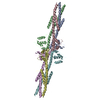+検索条件
-Structure paper
| タイトル | A meiotic driver hijacks an epigenetic reader to disrupt mitosis in noncarrier offspring. |
|---|---|
| ジャーナル・号・ページ | Proc Natl Acad Sci U S A, Vol. 121, Issue 45, Page e2408347121, Year 2024 |
| 掲載日 | 2024年11月5日 |
 著者 著者 | Yu Hua / Jianxiu Zhang / Man-Yun Yang / Fan-Yi Zhang / Jing-Yi Ren / Xiao-Hui Lyu / Yan Ding / Fang Suo / Guang-Can Shao / Jun Li / Meng-Qiu Dong / Keqiong Ye / Li-Lin Du /  |
| PubMed 要旨 | Killer meiotic drivers (KMDs) are selfish genetic elements that distort Mendelian inheritance by selectively killing meiotic products lacking the KMD element, thereby promoting their own propagation. ...Killer meiotic drivers (KMDs) are selfish genetic elements that distort Mendelian inheritance by selectively killing meiotic products lacking the KMD element, thereby promoting their own propagation. Although KMDs have been found in diverse eukaryotes, only a limited number of them have been characterized at the molecular level, and their killing mechanisms remain largely unknown. In this study, we identify that a gene previously deemed essential for cell survival in the fission yeast is a single-gene KMD. This gene, , kills nearly all progeny in a × cross. By analyzing polymorphisms of among natural strains, we identify a resistant haplotype, HT3. This haplotype lacks killing ability yet confers resistance to killing by the wild-type . Proximity labeling experiments reveal an interaction between Tdk1, the protein product of , and the epigenetic reader Bdf1. Interestingly, the nonkilling Tdk1-HT3 variant does not interact with Bdf1. Cryoelectron microscopy further elucidated the binding interface between Tdk1 and Bdf1, pinpointing mutations within Tdk1-HT3 that disrupt this interface. During sexual reproduction, Tdk1 forms stable Bdf1-binding nuclear foci in all spores after meiosis. These foci persist in germinated progeny and impede chromosome segregation during mitosis by generating aberrant chromosomal adhesions. This study identifies a KMD that masquerades as an essential gene and reveals the molecular mechanism by which this KMD hijacks cellular machinery to execute killing. Additionally, we unveil that losing the hijacking ability is an evolutionary path for this single-gene KMD to evolve into a nonkilling resistant haplotype. |
 リンク リンク |  Proc Natl Acad Sci U S A / Proc Natl Acad Sci U S A /  PubMed:39485795 / PubMed:39485795 /  PubMed Central PubMed Central |
| 手法 | EM (単粒子) |
| 解像度 | 2.7 Å |
| 構造データ | EMDB-61290, PDB-9ja5: |
| 化合物 |  ChemComp-HOH: |
| 由来 |
|
 キーワード キーワード | CELL CYCLE / signaling protein / meiotic cell cycle |
 ムービー
ムービー コントローラー
コントローラー 構造ビューア
構造ビューア 万見文献について
万見文献について






 streptococcus sp. group g (バクテリア)
streptococcus sp. group g (バクテリア)